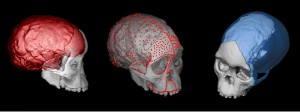
To reconstruct means "to establish or assemble something again" which inevitably involves an idea of how this something was before it fell apart or was damaged.
Reconstruction of biological objects for various applications, from forensics to human evolution, refers mostly to the
- reassembly of broken parts of a single specimen,
- the estimation of missing parts, and
- the speculations about soft tissue.
As stated above, all these activities are based on very strong assumptions, whether or not explicitly stated. In anthropology, for instance, precious remains of human ancestors are typically reconstructed by a prominent authority and eventually disseminated via images or casts. After that, though, there is often a tendency among researchers to take the reconstruction for granted "as is" without much appreciation of the considerable uncertainties involved and the preconceptions that implicitly shaped it.
Difficulties of reconstruction
A common joke among pollsters says "Prediction is difficult, especially of the future". For anthropologists, the slogan might be instead "Reconstruction is difficult, especially of the past". In both fields, unavailable data has to be estimated, but while opinion research is mostly based on quantitative data, reconstructions in paleoanthropology are often a matter of the so-called "morphological eye". Virtual Anthropology tries to contribute to more objective and reproducible standards in reconstruction, generally because the assembly of parts and the estimation of missing parts are according to definable references. We can distinguish between three approaches to reconstruct a form: Anatomical reconstruction, geometric reconstruction (reference based) and statistical reconstruction (reference based). The physical method can only use the anatomical approach, whereas in Virtual Anthropology, also reference based reconstruction is available.
Nevertheless, virtual reconstructions need assumptions as well, most importantly the choice of a reference specimen or population, or else a selection of anatomical constraints. Either way, the reconstruction has still an advantage: it can be repeated without touching the original.
Missing Data
If a form is distorted, parts have been broken off, or its surface details have been obscured, we have to deal with "missing data" from a statistical point of view.
Anatomical Reconstruction
Essentially, anatomical reconstruction follows the principles of traditional physical reconstruction using anatomical clues to reconstruct a biological form.
Reference based reconstruction
Since rich digital data is available in Virtual Anthropology, the process of reconstruction can be enhanced in ways to which physical reconstruction has no access.